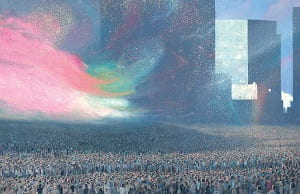 In the Antarctic the polar ice sheet is breaking up, and there’s sunbathing in Arctic Siberia. While Corona-virus imperils us at personal and societal levels, at the macro-level entire ecosystems are collapsing.
In the Antarctic the polar ice sheet is breaking up, and there’s sunbathing in Arctic Siberia. While Corona-virus imperils us at personal and societal levels, at the macro-level entire ecosystems are collapsing.
Here are some outstanding books that deal with the climate crisis, environmental degradation, pollution, deforestation, habitat loss – and what we and our young readers can do about these problems.
Credit is due to ex-colleagues, on whose reviews I have built some of these thumbnail descriptions: thanks to Jamie, Lucy, and Laura.
While much of print publishing is struggling, children’s book publishing, in all genres, is booming. There are a lot of established and well-respected publishing houses, and an increasing number of inspired new start-ups jostling for market share. Bear this in mind when selecting books: there can be a bandwagon effect as editors spot what’s trending and encourage their authors to write with one eye on the market.
Recent trends have included:
- Citizenship and social justice
- Tales of inspirational real-life role models
- Environmental concerns
- Identity, self-help, and mental health.
The first three of these are represented in some terrific books based around the environment and the climate crisis. It will be interesting to see whether the current pandemic and consequent worries for children’s mental health gives an even greater boost to the fourth trend listed above.
The following selection of books from the Curriculum Centre collection is loosely arranged around:
- Fairy tales old and new
- Picture books, for younger and older readers
- Information books
- Fiction: junior, middle, and YA
Let’s set the scene with a quote from the great Shaun Tan:
“We like to look at things from unusual angles, attempt to seek some child-like revelation in the ordinary, and bring our imagination to the task of questioning everyday experience. Why are things the way they are? How might they be different?” [www.shauntan.net, accessed 9/7/2020]
 Shaun Tan, Tales from the inner city (2018)
Shaun Tan, Tales from the inner city (2018)
Winner of the 2020 Kate Greenaway Medal
This fabulously illustrated book comprises a series of surreal tales delving into our relationship with animals, our ability to ignore uncomfortable truths of animal welfare and ecological breakdown.
And yet we also seem to disrespect animals greatly, when you look at the way they are treated, the destruction of their habitat, the cruelties of factory farming, and many other deprivations and injustices. And that’s just by our own measure. There are no doubt further problems we are not aware of, inadvertently or willfully…” (Shaun Tan, see here: author comment on publishers’ website, accessed 17/7/2020)
Shelved in Picture books 8 – adult
There is a telling illustration of this in a very recent article about the ways in which human-generated auditory stress has impacted all levels of marine fauna, from whales to scallops, and how they are thriving in its CV-19-driven absence. Read more here.
Traditional tales, fables and fairy stories
Mrs Noah books (2017; 2020)
Two books inspired by the Biblical flood, by Jackie Morris, illustrated by James Mayhew – with clear parallels with present-day rising sea levels.
Shelved in Myths and Legends
The last wolf, by Mini Grey (2019)
Mini Grey at her best – an environmental twist on the Red Riding Hood Story. Featuring a fearless heroine, armed with her popgun, this witty tale carries a serious message about deforestation, environmental degradation, and the inter-connectedness of living things.
Shelved in Picture books 8 – adult
 The last tree, by Emily Haworth-Booth (2020)
The last tree, by Emily Haworth-Booth (2020)
A group of friends look for a place to call home. With echoes of Goldilocks, they find the desert too hot, the valley too wet and the mountain too windy. The forest was perfect. The leaves gave shelter and a gentle breeze wound through the branches. But in order to build they cut down the trees, and the forest thins until there is just one last tree standing. Can the friends to find a solution? Shelved in Picture books
 La petite soeur de chaperon rouge by Didier Lévy, ill. Clotilde Perrin (2015)
La petite soeur de chaperon rouge by Didier Lévy, ill. Clotilde Perrin (2015)
In this French book, Red Riding Hood has grown up and become rich and famous, but her feisty little sister, Carlotta, makes friends with the old wolf—now without any teeth. He introduces her to the forest and its inhabitants. When habitat destruction is threatened, Carlotta turns to environmental activism and saves her friends and their forest home. This is a large format, richly illustrated book that is a joy to leaf through. It’s a longer read, but the pictures and the familiar fairy tale themes help to support a patient reader.
Shelved in Modern Languages: French Picture Books
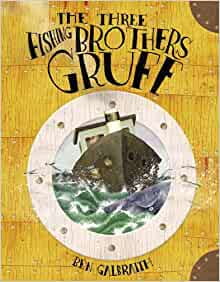 Ben Galbraith, The three fishing brothers Gruff (2006)
Ben Galbraith, The three fishing brothers Gruff (2006)
This fairy tale revision deals with the environment, sustainability, and pollution. It is also about greed and selfishness, and our individual impact, for good or for bad. It should be a great way to get children thinking about how we can take care of the environment we live in.
Shelved in Picture books 8 – adult
Picture books
 Clem and Crab by Fiona Lumbers (2020)
Clem and Crab by Fiona Lumbers (2020)
Clem discovers Crab tangled up in a plastic bag at the bottom of her bucket, after she has collected objects from the beach. A picture book story with a strong environmental message. It shows how small actions can make a big difference. It was shortlisted for Picture Books to Shout About: West Sussex Children’s Picture Book Award 2019-2020. (Quoted from Laura’s blog post, 28/11/2019)
Shelved in Picture Books
 The promise by Nicola Davies, illustrated by Laura Carlin (2013)
The promise by Nicola Davies, illustrated by Laura Carlin (2013)
Davies’ language and Carlin’s illustrations mesh beautifully to convey the importance of our relationship with nature. Truly a story for all of us: the powerful message is told so simply. Nicola Davies has spoken of unpicking the hard boundaries between fact and fiction, and doesn’t distinguish between the two in her work. Her fiction is often inspired by and addresses real-life social or environmental concerns.
Shelved in Picture Books 8 – adult
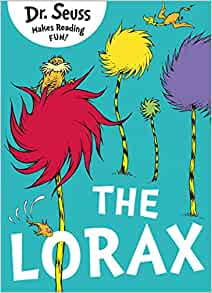 Dr Seuss, The Lorax (our copies 1972 and 2009)
Dr Seuss, The Lorax (our copies 1972 and 2009)
First published in 1971, this modern classic is evidence that concerns for the environment have a long history. “UNLESS someone like you…cares a whole awful lot…nothing is going to get better…It’s not.” Dr. Seuss, speaking through his character the Lorax, warns against mindless progress. His classic cautionary tale shows that good children’s literature doesn’t have to be simplistic or have a happy ending.
Shelved in Picture books
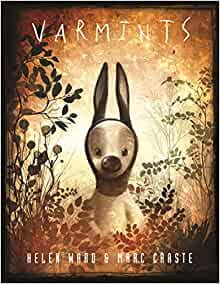 Helen Ward, Varmints (2013)
Helen Ward, Varmints (2013)
This picture book is a powerful and beautiful modern fable for older children. It tells of a simple creature whose peaceful pastoral life gets swept away in a tidal wave of urban development, as he tries to save one small part of his former life. Our young cataloguer added this review back in 2009. “A brilliant cautionary tale for our world, yet with a glimmer of hope, that conveys so much with its simple words and stunningly beautiful pictures, it has now been made into a 24 minute film of the same name. I fully recommend taking just five minutes to read this wonderful book.” (Jamie’s review, 07/12/09).
Shelved in Picture Books 8 – adult
Picture books for older readers
 Levi Pinfold, Greenling (2006)
Levi Pinfold, Greenling (2006)
This strange, uncanny story shines a light on the problems of resisting the power of nature, and the consequence impact of such resistance on human relationships. There is a huge amount to explore, in the ambiguity of the symbolism, the fabulous artwork, the purposeful use of colour and shape.
Shelved in Picture Books 8 – adult
 Brian Moses, Dreamer: saving our wild world (2018)
Brian Moses, Dreamer: saving our wild world (2018)
“I dreamt I was a whale and no hunters chased after me…I dreamt I was a rainforest and no one felled a single tree…” One child dreams of a world where wild creatures are safe and free to roam, where water is clean and air is pure. This inspirational picture book is a call to all of us to stand up for the future of our planet and help to save our wild world.
Shelved in Picture books
 Phoebe Swan, King Leonard’s teddy (2019)
Phoebe Swan, King Leonard’s teddy (2019)
Don’t throw things away; mend them. With a strong environmental message, this story shows the folly of waste and consumerism, and the value of tending to the things we love.
Shelved in Picture books
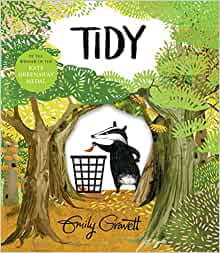 Emily Gravett, Tidy (2016)
Emily Gravett, Tidy (2016)
An obsession with clearing up goes too far, and eventually a badger concretes over everything in his quest for tidiness. A vibrantly illustrated and charming story that highlights the futility of asserting boundaries upon nature and battling for order in the outdoors, this is brilliant and very funny.
Shelved in Picture Books 8 – adult
 Sandra Dieckman, Leaf (2017)
Sandra Dieckman, Leaf (2017)
Leaf the polar bear collects leaves to make wings so that he can fly home to his family from whom he was separated because of the melting ice. There’s a simple environmental message here, conveyed through the eyes of a lonely polar bear, but this is also an exploration of ‘othering’ and the refugee experience. Told so straightforwardly, yet containing such deep themes, this should appeal to a wide age range.
Shelved in Picture books
From the award-winning author with one of the most original voices in children’s literature, to bridge over into the information books section, here is a picture book that defies pigeon-holing:
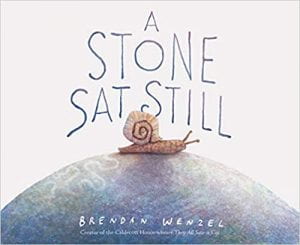 Brendan Wenzel, A stone sat still (2019)
Brendan Wenzel, A stone sat still (2019)
With stunning illustrations in cut paper, pencil, collage, and paint, and soothing rhythms that invite reading aloud, A Stone Sat Still is a gorgeous exploration of perspective, perception, sensory experience, color, size, function, and time, with an underlying environmental message that is timely and poignant. (From Brendanwenzel.info, accessed 4/12/2019.)
Shelved in Picture books
Information books
Here are some non-fiction books that are so beautifully written they count as good quality children’s literature.
 Eun-Ju Kim, Plastic: past, present and future (2019)
Eun-Ju Kim, Plastic: past, present and future (2019)
Starting with the now-famous account of a shipment of bath toys spilling into the Pacific Ocean and making their way across the globe, the author uses a narrative nonfiction style to explain the topic of plastics to young children. Even-handed and informative, the book details the many helpful uses of plastic, as well as its damage to the environment. Recycling is not a catch–all solution for plastics, and young readers are encouraged to reduce single-use plastic consumption, and to learn about innovative solutions from scientists and activists. Ji-Won Lee’s bold and helpful illustrations show people with varied skin tones. Shelved in Science
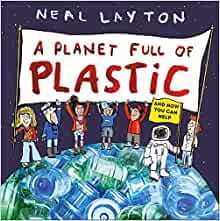 Neal Layton, Planet full of plastic and how you can help (2019)
Neal Layton, Planet full of plastic and how you can help (2019)
Layton’s irrepressible positivity explains the facts around plastic for younger children while also outlining simple, achievable remedies that children can achieve themselves. Mixing in photographs of real plastic pollution, superimposed on the artwork, drives reality home.
Shelved in Science
The young heroine of environmental activism, Greta Thunberg, has inspired several books, and, of course, written her own.
Every year, the Federation of Children’s Book Groups (FCBG) organises National Non-Fiction November. The theme for 2020 is to be ‘The Planet We Share’. Check the FCBG website nearer the time for excellent book recommendations, teaching ideas and resources.
Fiction
 Rebecca Stead, First light (2014)
Rebecca Stead, First light (2014)
An alternative world, tightly plotted, environmental fantasy, captured in this rave review on Goodreads: What an amazing, tense adventure! What fun! What a fantastic premise! And so well-plotted and clearly well-researched! Arctic explorers! Polar ice caps! Sled dogs! Two intertwined stories! Amazing! I could have read on and on! Such a great book! I’m now kicking myself for not picking this up the first time I heard Stead’s name! (Thanks Jessica – and Goodreads.)
Shelved in Fiction (Junior/Middle)
 Marcus Sedgwick, Floodland (2000)
Marcus Sedgwick, Floodland (2000)
Winner of the Branford Boase Award 2001, Marcus Sedgwick’s powerful debut novel, about surviving in a sinking world, marked the beginning of the author’s multi-award-winning career. It’s a short but gripping tale of environmental disaster, the consequent collapse of civilisation, and moral dilemmas.
Shelved in Fiction (Middle)
 Saci Lloyd, The Carbon Diaries 2015 (2008)
Saci Lloyd, The Carbon Diaries 2015 (2008)
Written in 2008, this story is set in the near future where carbon rationing has been introduced to halt climate change. Everyone is issued with a carbon allowance card which gives you a very limited amount of points to use for everything. This means no flights, cars for emergency use only, only locally made food, hardly any heating, choosing between using the hairdryer or boiling the kettle. Would you choose your laptop over having a fridge? This book would encourage lively discussion on imagining what life would be like on carbon rationing. The fact that this could be entirely possible makes it even better. Written in diary form by teenager Laura, this book is aimed at ages 11+ and there is also a following book, The Carbon Diaries 2017. (Lucy’s review, 23/7/2014)
Shelved in Fiction (Middle/Secondary)
 Nicky Singer, The Survival Game (2018)
Nicky Singer, The Survival Game (2018)
‘Mhairi owns only two things: a gun with no bullets and her identity papers.’
A dystopian novel, shortlisted for the Southern Books Award in 2020, in which two characters journey to safety in a world devastated by global warming and climate change.
Shelved in Fiction (Young Adult)
 Jan Mark, Useful idiots (2004)
Jan Mark, Useful idiots (2004)
Set in a realistic dystopian future, where the lowlands of Britain are flooded, this novel explores a world where archaeology is banned for fear of social unrest. The ending divides readers: some feel it falls flat, other relish the moral ambiguity: there is no clear right or wrong, no good person or bad person. We feel sympathy with the indigines, but they turn from oppressed to oppressor. Many issues to explore here for a YA audience.
Shelved in Fiction (Secondary/Young Adult)
Finally, a couple of books from other sections of the Centre:
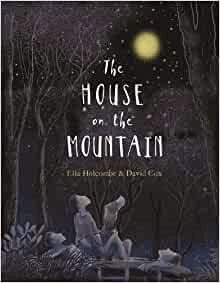 Ella Holcombe, The house on the mountain (2019)
Ella Holcombe, The house on the mountain (2019)
The severity of widespread bushfires is both a symptom of global warming, and a contributor to it. After the recent horrendous bushfire in Australia, with the TV news footage still frightening and fresh in our minds, this evocative story from the devastating February 2009 bushfires brings the human experience vividly to life. See this review we posted earlier.
Shelved in Geography 4d
 Innosanto Nagara, A is for activist (2013)
Innosanto Nagara, A is for activist (2013)
‘A is for activist’, written and illustrated by Innosanto Nagara: a board book with a difference. Positive, uplifting messages to get children thinking and talking. The board book format belies the wide age range that would enjoy this book, but the sturdy format fits the strong message.
Shelved in Citizenship 1: Primary
What’s heartening is that so many of these books are a rallying call for action or reflect the action that young people are already taking all around the world.
All these books are available for reference in the Curriculum Centre – or will be, once we reopen, risk assessments permitting. In the meantime, I am happy to respond to enquiries by e-mail. Use the link on the catalogue, or our shared mailbox curriculumcentre@brighton.ac.uk. Suggestions and book recommendations are also welcomed.







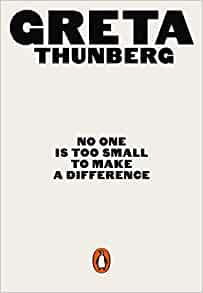
One thought on “Climate change in children’s books”